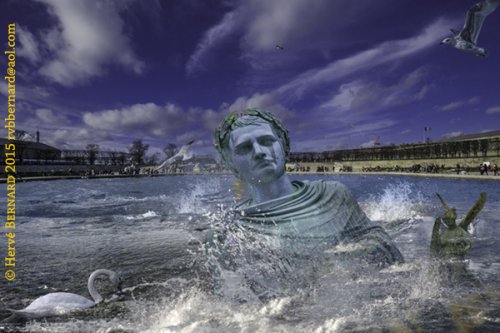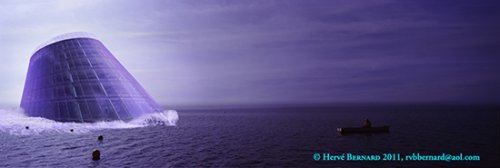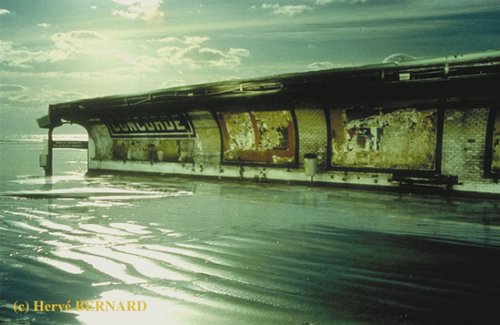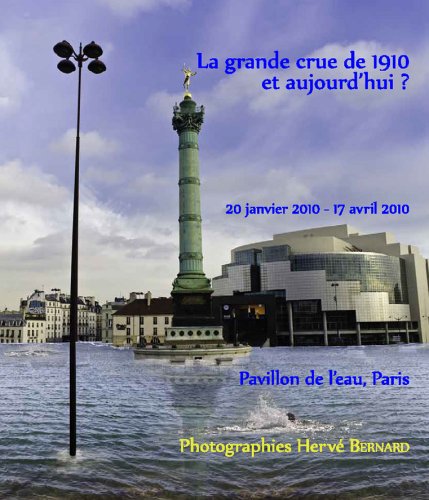« Et, si c’était vrai... / And, if that was true... »
A cycle on flooded towns, a stroll through anthropocene
A coverage back to the future ; a long term travel about urbanism and water management
by Hervé Bernard

1 Introduction
It started with an order from Eau de Paris to celebrate the anniversary of the floods of the Seine in 1910. This was extended by a photographic exhibition on contemporary flooded Paris (Water Pavilion, Paris, January 2010-May 2010). Very quickly, I realized that this work could have no scientific truth, as geographical, geological and technological conditions are completely different from those of 1910, so I focused my thoughts especially in the direction of global warming. Subsequently, this exhibition is titled ’Paris in his bed’. Paris in his bed—Paris dans son lit
In its second showing, the exhibition was complemented by images of flooded Amsterdam. The set was presented at Maison Descartes (French Cultural Institute in Amsterdam) under the title : Living with Water / Water puts Leben November 2011 to January 2012 Living with / Leben met Water.
It was with this second city that I began to understand something that had only occurred to me when creating the work on Paris. Beyond climate instabilities (storms, tornadoes...) that have always existed, beyond the threat of global warming, these images were also urban exploration, a way to revisit these cities by adopting an unusual perspective : looking as if we suddenly lived in the first or second floor and were trying to make visitors discover unknown places. This was the case with the statue of Liberty in Paris or the NDSM area, or the Nemo Museum in Amsterdam, where many visitors suddenly discovered its naval forms.
In Amsterdam, besides the obvious presence of water, my attention was drawn to the important work done during the conversion of the northern industrial district (NDSM), adapting it to contemporary requirements while the temptation to make a tabula rasa was great. Thus, I wanted to emphasize the economic and ecological strategy. Ecological because concrete is a major consumer of water and energy, concrete production is a big carbon generator. Also in the field of urban planning, I found that many contemporary buildings have a shape close to that of a ship.
“Et, si c’était vrai. 2010-2080... Perspectives… Retour vers le Futur/ And, if that were true2010-2080... Perspectives… Back to the Futur...” reveals the importance of water and rivers in the planning of these cities. Beyond that, it takes a look at the mood of their environment. Thus, the ’Paris imagined’ when exposed to Water Pavilion is a Paris where, despite the floods, these characters take ownership of the event and take the opportunity to turn this city into a huge new leisure center : an outboard motorboat in the Grand Palais, a swimmer practicing the butterfly stroke on the Bir-Hakeim elevated metro bridge... it’s one way to translate the Paris of the Roaring Twenties into contemporary Paris whilst evoking the importance of tourism, which has become the economic heart of the French capital. As these examples show, I reject dramatization for its paralyzing effects.

“And, if that were true2010-2080... Perspectives… Back to the Futur...” extends a central question of the image, probably one of the backbone of my work : the relationship between image and reality, an issue developed in my book Regard sur l’image a richly illustrated essay featured on the eponymously titled blog, Regard sur l’image and in the preface by Peter Knapp. As the name suggests, these images question the relationship between reality and fiction.
“And, if that were true2010-2080... Perspectives… Back to the Futur...” also speaks of foresight and the need for medium and long term thinking to transform a world built on a short-term strategy.
2 Review of my reportage to the Futur.
Make acceptable to my contemporary fellow from the decade 2010th that the images which I shot in decade 2080th were really shot in 2080 turned out to be impossible. Collateral damage of movies as Stargate, Titanic and others blockbusters. Consistently, only one status : fake.
I was faced back to a solo option :
– let it down this attempt to awareness and in the same time treating them of conscienceless blind people, selfish and worst called names them :
– or find a way they not looked toward this images and then attempt to oriented their way of being to a more responsible attitude. It has occurred to me it was more efficient to let them believed this reportages was photomontaged pictures. Which doesn’t required me any endeavor as they are convince of it. And from this point of vue, at least they are listening to me.
I continue my travels in 2080 and I am, consistently, bringing back photos to attempt to push forward the mentalities and things in 2010th. For sure, the compromising is big but if it the price I have to pay to influence the way of being, I am ready to pay it. What is significant is the achievement no matter the way to ridge it.
Furthermore, I have to recognize I earn a personal profit : people believed I am an expert in digital effects while I am just shooting during a promenade to the future. Beyond the compromising to let people believed that my reportages are photomontages, the question is to know what I have to say to be listened by the public opinion and by the our contemporary leaders (2010 decade) to avoid this future.
3 Then comes the way to say it
About the way, my ruling to let people believe this images are rigged involve surrender about all the arguments surrounding reportage and leave few choices. Despite is realism, this work will be presented as a fiction. Furthermore, as terror is not efficient to help change mentalities on a middle or long term, I took the side to eliminate terrifying images to draw attention of people today to take action against global warming. Humor educational virtues doesn’t need anymore to be demonstrated.

– or this purpose, I draw on my image maker background, six museums have already baught my pictures. Among them, I am using this quote of Laurent Gervereau, director of Le Musée du Vivant : when he was discovering my work. You make destruction esthetic, you make beautiful with ugly ! Which I answered by : Awfulness, destruction produce escape. Making esthetic constraint to look at and, then face to the situation. It is this face to face which make realizing that we have to act, no matter the level.
I will rely on my euopean publications, exhibitions and awards. This elements should give credibility to my purpose. I have already exhibited this “reportages” about water rising in Le Pavillon de L’Eau (Paris in his bed, 2010) and at La Maison Descartes/Institut Culturel Français in Amsterdam (residency and an exhibition titled Vivre avec l’eau / Leben met Water 2011

Then follow The Water Crest and Scums I exhibition during the 6th World Wide WaterForum (Marseille 2012) and The Water Crest and Scums II movie awarded in Deauville GreenAward Film Festival2016 and The Water-Etching—Water-Running movie awarded in the same festival.
Each of this reportages done in 2010 decade and 2080 decade will have is own title. Putting together, the all will build And, if that were true2010-2080... Perspectives… Back to the Futur... My choice is to not only work on seaside town. For sure, they are first concerned by but as one will be affecting others, a sort of vessel communication, all the towns build on a riverbank or a lakebank are concerned too. Aa a matter of fact the water rising will change drasticly the rains rythm and intensity..
 Regard sur l’image
Regard sur l’image




